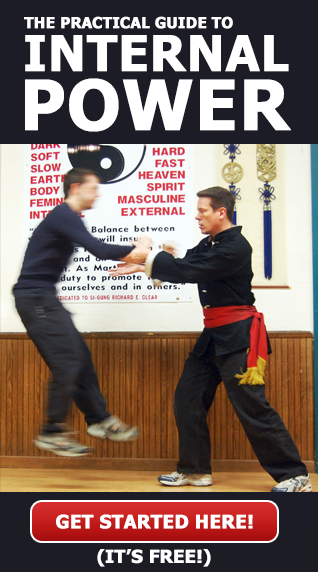As I stated earlier Tai chi locks are commonly referred to as Tai Chi Qin Na. Qin Na is a commonly used spelling for Chi Na. Qin means to seize or trap and Na means to lock or break. In this post I want to focus on the locking or breaking aspect of the Qi Na and how the mind is used to affect the application of Tai chi Locks.
Lets say that you have a person in an armbar. In Tai Chi you could easily be using Brush Knee, Wild Horse Tosses Mane or any number of other moves to do this but for now I will focus on a basic Brush Knee application because it is the same position that most people think of for an elbow break.
You have the opponents wrist grabbed with one hand and your other hand is pushing behind their elbow in an elbow breaking position. The opponent bends and tenses up there arm. A natural and fairly common reaction to someone trying to break you elbow. A skilled Tai Chi Qin Na practitioner does not have to move their hand position in order to compensate for this resistance. Instead, turn a bit just like the Brush Knee move does and lengthen their arm position. The average untrained person can normally continue to protect their elbow but will typically do so at the expense of their shoulder either hyperextending or rolling over. At this point the Tai Chi Qi Na practitioner can choose to roll the arm over a bit and hyper extend the arm for a break at the shoulder or a break at the elbow or use the roll to distribute the force (and the application of body weight) anywhere on the upper arm between the elbow and the shoulder. A skilled practitioner can also extend intention past the shoulder and into the recipients back.
With practice (carefully so as to not hurt or harm your practice partner) you will be able to fairly easily move the force around anywhere you want it to go in the upper body and with a bit more practice and or skill you will be able to get the force into the midsection and legs. The better your sensitivity skill is and the more developed your projection of intention is the more profound of an effect that you can have.
I used the elbow break position for my first example. (Do not break or harm your training partner / friends.) Carefully try the position and you should be able to get some results. Be very careful not to injure your partner or break their arm. Remember not to give them any more force / pain than they are willing to receive and certainly no more than you want them to give you.
Feel inside the other person and see if you can feel the various places of tension and the movement of tension inside their body. Then, see if you can focus that tension to a specific area and with minimal force keep it there even while they are moving and trying to dissipate or redistribute the tension to somewhere else. Then, with your focused mind (mind intent) move the tension to another spot and do it again. When you can move it anywhere inside of them you want including down into their legs then you are beginning to get the idea of the internal aspects of Tai Chi Qin Na.
Once you begin to understand the real application of Tai Chi Qin Na then try other Tai Chi locks with this approach. With sustained training eventually you will be able to grab someone anywhere and use Tai Chi Qin Na skills to lock onto the inside of their body anywhere and hold it adding the true internal dimension to your seizing skills.

Speak Your Mind